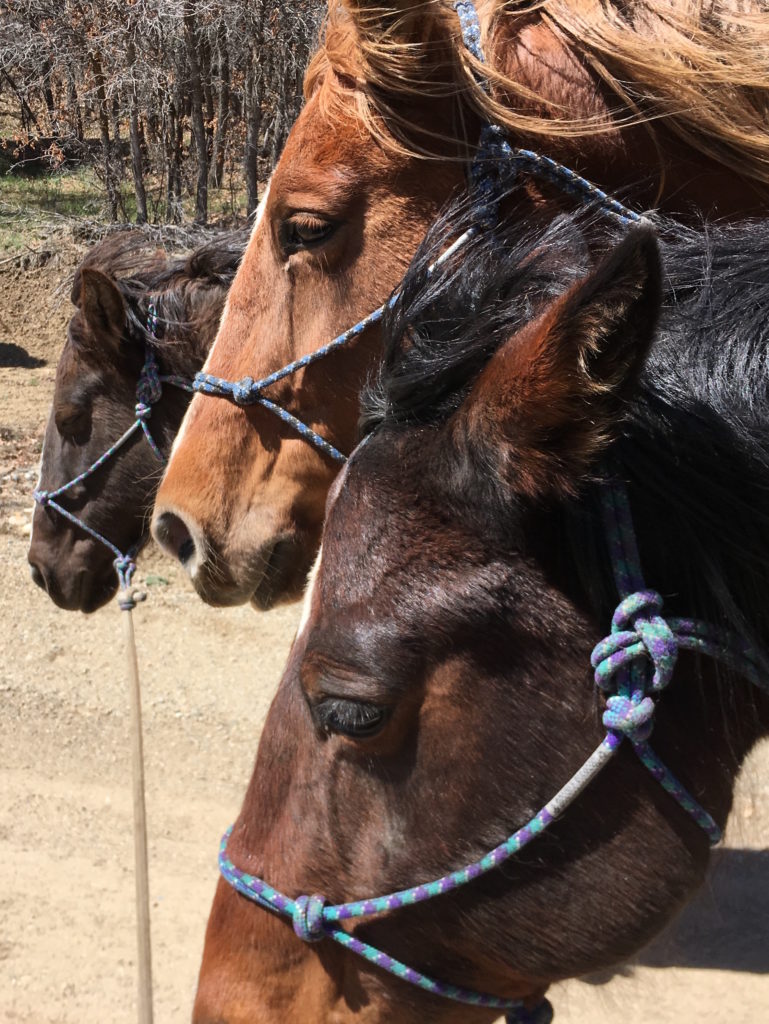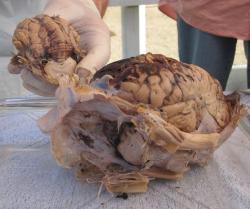Horses are not people. We know this is true. But attend any horse event, enter any tack shop, open any horse magazine and you’ll come away thinking otherwise.
 You’ll be convinced horses have feelings, motivations, and goals. We tend to replace their simple needs with our more complicated ones. We anthropomorphize; we make horse actions personal and emotionally complex.
You’ll be convinced horses have feelings, motivations, and goals. We tend to replace their simple needs with our more complicated ones. We anthropomorphize; we make horse actions personal and emotionally complex.
- He likes kisses.
- He needs his breakfast, lunch, and dinner.
- Look, he’s nodding, “Yes!”
- We’re friends. He loves me!
It’s fun but it’s wrong. Of course, horses DO have feelings, motivations, and goals. But from a scientific point of view, they’re much more basic than we think:
- They want to move.
- They want to forage.
- They want to rest.
- They want to be with other horses.
The horse brain is about the size of two human fists. At a recent Evidence-Based Horsemanship seminar, Dr. Steve Peters carved out the cerebellum, a tangerine-sized brain part and what he called the “juke box of motor memory.”

Dr. Steve Peters begins horse brain dissection
Among other things, the cerebellum is essential for balance. When a horse learns to walk, run, kick, sidepass, and change leads, all that information or “muscle memory” is stored in the cerebellum.
Assuming a young horse has been allowed to move and interact with other horses, you’re not really going to train it to do anything physically. Training is much more about horse/human interaction. Also, a lot of our horse work has to do with getting out of the way, staying off the reins, letting the horse balance itself, etc.
What we didn’t see during Dr. Peters’ dissection was a huge frontal lobe. That’s the part of the brain responsible for making plans, forming strategies, learning to generalize. That’s because horses, unlike humans, don’t have a huge, developed frontal lobe.
Horses don’t have it in for you. They don’t lie or plot. They don’t have a laugh at your expense. Nor do they do something for charity or to redeem themselves. It isn’t in them to do those things. Literally.

Peters holds the cerebellum
The interesting thing is that some horses in some situations learn and behave in more complex ways. We know that the frontal lobe is comparatively small , and that most of an equine’s brain is devoted to sensation and movement . Yet, we see horses solve problems by trial and error, when they are motivated . And sometimes they just seem to know things they have no business knowing ! So much more study is needed to uncover these mysteries- it will never be boring .
Firstly, thank-you for providing evidence against the “walnut size brain” myth that has been around for decadess!!
Secondly, while we know quite a bit about brain structure, we still have a lot to learn about brain function, e.g. neuroplasticity as it relates to spinal cord injuries is a relatively new concept.
Thirdly, not enough is known to say that horses do not have feelings. Attachment theory research has shown repeatedly that animals (including horses) are capable of forming strong attachments. Similarly, animals feel,… feelings of fear, safety, comfort. They cannot think about what they feel, as we do and perhaps do not have the range of feelings that we do, but feel (possessing feelings) they do.
And definitely horses do not plot or scheme,… however they can learn troublesome behaviours,… and typically it is ‘us humans’ who have invited/taught those behaviours (born out of the flight or fight response) when they feel fear.
My horse is a male horse and he really like to kiss me on my mouth .Spontaneously he do this. He feels something for me. Horses also can get angry. When a woman screamed to her horse to galopp and the horse didnt want to galopp the horse got irritated on her. And the horse showed that to her.
At a time a was very sorry in my life. A horse that I sometimes used to ride understood that so she changed her behaviour. When I should brush her before riding she started to come with her nose to me and strike me. For about 5 minutes until I continued for riding.
The more that these scientists can discover about how the brain works, the better our relationships with the horse can become because we can start to really understand how the horse pictures the world and takes it all in. It will take our communication to a whole new level. They certainly have feelings but it is humans that seem to make up the story of what the horse is feeling from our own human terms.
Horses may have comparatively small brains, but they have incredible memory, and as was demonstrated by Dr. Keyes, horses can be taught to recognize letters in the alphabet, count, and demonstrate pretty abstract thought, like the difference between political parties! Beautiful Jim Key was one such horse. He was instrumental in creating the humane movement of the late 19th century.